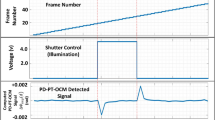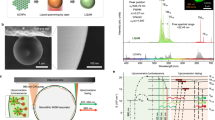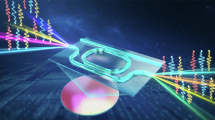Abstract
The goal of this protocol is to improve the characterization and performance standardization of multiphoton microscopy hardware across a large user base. We purposefully focus on hardware and only briefly touch on software and data analysis routines where relevant. Here we cover the measurement and quantification of laser power, pulse width optimization, field of view, resolution and photomultiplier tube performance. The intended audience is scientists with little expertise in optics who either build or use multiphoton microscopes in their laboratories. They can use our procedures to test whether their multiphoton microscope performs well and produces consistent data over the lifetime of their system. Individual procedures are designed to take 1–2 h to complete without the use of expensive equipment. The procedures listed here help standardize the microscopes and facilitate the reproducibility of data across setups.
Key points
-
The best practices for the quantification of the performance of multiphoton microscopes are described, necessary to overcome the wide user- and facility-dependent variations in microscope calibration, which inevitably affect the reproducibility of data across laboratories.
-
The procedures cover laser power, pulse width optimizations, field of view, resolution and photomultiplier tube performance and the majority should be carried out on a regular basis for maintenance of the system.
This is a preview of subscription content, access via your institution
Access options
Access Nature and 54 other Nature Portfolio journals
Get Nature+, our best-value online-access subscription
$32.99 / 30 days
cancel any time
Subscribe to this journal
Receive 12 print issues and online access
$259.00 per year
only $21.58 per issue
Buy this article
- Purchase on SpringerLink
- Instant access to full article PDF
Prices may be subject to local taxes which are calculated during checkout



















Similar content being viewed by others
References
Goppert-Mayer, M. Elementary file with two quantum fissures. Ann. Phys. 9, 273–294 (1931).
Denk, W., Strickler, J. H. & Webb, W. W. Two-photon laser scanning fluorescence microscopy. Science 248, 73–76 (1990).
Debarre, D., Olivier, N., Supatto, W. & Beaurepaire, E. Mitigating phototoxicity during multiphoton microscopy of live Drosophila embryos in the 1.0–1.2 mu m wavelength range. PloS ONE 9, 12 (2014).
Schonle, A. & Hell, S. W. Heating by absorption in the focus of an objective lens. Opt. Lett. 23, 325–327 (1998).
Podgorski, K. & Ranganathan, G. Brain heating induced by near-infrared lasers during multiphoton microscopy. J. Neurophysiol. 116, 1012–1023 (2016).
Stujenske, J. M., Spellman, T. & Gordon, J. A. Modeling the spatiotemporal dynamics of light and heat propagation for in vivo optogenetics. Cell Rep. 12, 525–534 (2015).
Schmidt, E. & Oheim, M. infrared excitation induces heating and calcium microdomain hyperactivity in cortical astrocytes. Biophys. J. 119, 2153–2165 (2020).
Magidson, V. & Khodjakov, A. Circumventing photodamage in live-cell microscopy. Methods Cell Biol. https://doi.org/10.1016/B978-0-12-407761-4.00023-3 (2013).
Icha, J., Weber, M., Waters, J. C. & Norden, C. Phototoxicity in live fluorescence microscopy, and how to avoid it Bioessays https://doi.org/10.1002/bies.201700003 (2017).
Nadiarnykh, O., Thomas, G., Van Voskuilen, J., Sterenborg, H. & Gerritsen, H. C. Carcinogenic damage to deoxyribonucleic acid is induced by near-infrared laser pulses in multiphoton microscopy via combination of two- and three-photon absorption. J. Biomed. Opt. 17, 7 (2012).
Konig, K., Becker, T. W., Fischer, P., Riemann, I. & Halbhuber, K. J. Pulse-length dependence of cellular response to intense near-infrared laser pulses in multiphoton microscopes. Opt. Lett. 24, 113–115 (1999).
CFI75 water dipping series. Nikon Instruments Inc. https://www.microscope.healthcare.nikon.com/products/optics/cfi75-water-dipping-series (2024).
Semi-apochromat water dipping objectives for electrophysiology. Olympus LS https://www.olympus-lifescience.com/en/objectives/lumplfln-w/ (2024).
Young, M. D., Field, J. J., Sheetz, K. E., Bartels, R. A. & Squier, J. A pragmatic guide to multiphoton microscope design. Adv. Opt. Photonics 7, 276–378 (2015).
Smith, S. L. in Multiphoton Microscopy Vol. 148 (ed. Hartveit, E.) 1–16 (Humana, 2019).
Pawley, J. B. Handbook of Biological Confocal Microscopy (Springer, 2006).
Masters, B. R. & So, P. Handbook of Biomedical Nonlinear Optical Microscopy (Oxford University, 2008).
Ji, N., Freeman, J. & Smith, S. L. Technologies for imaging neural activity in large volumes. Nat. Neurosci. 19, 1154–1164 (2016).
Zinter, J. P. & Levene, M. J. Maximizing fluorescence collection efficiency in multiphoton microscopy. Opt. Express 19, 15348–15362 (2011).
Bumstead, J. R. et al. Designing a large field-of-view two-photon microscope using optical invariant analysis. Neurophotonics 5, 025001 (2018).
Zipfel, W. R., Williams, R. M. & Webb, W. W. Nonlinear magic: multiphoton microscopy in the biosciences. Nat. Biotechnol. 21, 1369–1377 (2003).
Heintzmann, R. & Sheppard, C. J. R. The sampling limit in fluorescence microscopy. Micron 38, 145–149 (2007).
Lu, R. W. et al. Video-rate volumetric functional imaging of the brain at synaptic resolution. Nat. Neurosci. 20, 620–628 (2017).
Quirin, S., Peterka, D. S. & Yuste, R. Instantaneous three-dimensional sensing using spatial light modulator illumination with extended depth of field imaging. Opt. Express 21, 16007–16021 (2013).
Weisenburger, S. et al. Volumetric Ca2+ imaging in the mouse brain using hybrid multiplexed sculpted light microscopy. Cell 177, 1050 (2019).
Song, A. et al. Volumetric two-photon imaging of neurons using stereoscopy (vTwINS). Nat. Methods 14, 420–426 (2017).
Tan, X. J. et al. Volumetric two-photon microscopy with a non-diffracting Airy beam. Opt. Lett. 44, 391–394 (2019).
Yang, W. et al. Simultaneous multi-plane imaging of neural circuits. Neuron 89, 269–284 (2016).
Helmchen, F. & Denk, W. Deep tissue two-photon microscopy. Nat. Methods 2, 932–940 (2005).
Gobel, W. & Helmchen, F. In vivo calcium imaging of neural network function. Physiology 22, 358–365 (2007).
Sherman, L., Ye, J. Y., Albert, O. & Norris, T. B. Adaptive correction of depth-induced aberrations in multiphoton scanning microscopy using a deformable mirror. J. Microsc. 206, 65–71 (2002).
Turcotte, R., Liang, Y. J. & Ji, N. Adaptive optical versus spherical aberration corrections for in vivo brain imaging. Biomed. Opt. Express 8, 3891–3902 (2017).
Visser, T. D. & Oud, J. L. Volume measurements in 3-dimensional microscopy. Scanning 16, 198–200 (1994).
Diel, E. E., Lichtman, J. W. & Richardson, D. S. Tutorial: avoiding and correcting sample-induced spherical aberration artifacts in 3D fluorescence microscopy. Nat. Protoc. 15, 2773–2784 (2020).
Wang, K., Liang, R. F. & Qiu, P. Fluorescence signal generation optimization by optimal filling of the high numerical aperture objective lens for high-order deep-tissue multiphoton fluorescence microscopy. Ieee Photonics J. 7, 8 (2015).
Takasaki, K., Abbasi-Asl, R. & Waters, J. Superficial bound of the depth limit of two-photon imaging in mouse brain. Eneuro 7, 10 (2020).
Kondo, M., Kobayashi, K., Ohkura, M., Nakai, J. & Matsuzaki, M. Two-photon calcium imaging of the medial prefrontal cortex and hippocampus without cortical invasion. eLife 6, e26839 (2017).
Yamaguchi, K., Kitamura, R., Kawakami, R., Otomo, K. & Nemoto, T. In vivo two-photon microscopic observation and ablation in deeper brain regions realized by modifications of excitation beam diameter and immersion liquid. PLoS ONE 15, e0237230 (2020).
Hampson, K. M. et al. Adaptive optics for high-resolution imaging. Nat. Rev. Methods Primer 1, 68 (2021).
Hirlimann, C. Femtosecond Laser Pulses: Principles and Experiments (Springer, 2005).
Dispersion (optics). Wikipedia https://en.wikipedia.org/wiki/Dispersion_(optics) (2023).
Sofroniew, N. J., Flickinger, D., King, J. & Svoboda, K. A large field of view two-photon mesoscope with subcellular resolution for in vivo imaging. eLife 5, 20 (2016).
Tai, S.-P. et al. Two-photon fluorescence microscope with a hollow-core photonic crystal fiber. Opt. Express 12, 6122–6128 (2004).
Zong, W. et al. Fast high-resolution miniature two-photon microscopy for brain imaging in freely behaving mice. Nat. Methods 14, 713–719 (2017).
Farinella, D. M., Roy, A., Liu, C. J. & Kara, P. Improving laser standards for three-photon microscopy. Neurophotonics 8, 015009 (2021).
Borzsonyi, A., Kovacs, A. P. & Osvay, K. What we can learn about ultrashort pulses by linear optical methods. Appl. Sci. 3, 515–544 (2013).
Hamamatsu Photonics KK. Photomultiplier Tubes: Basics and Applications (Hamamatsu Photonics K.K., 2017).
Wang, T. et al. Quantitative analysis of 1300-nm three-photon calcium imaging in the mouse brain. eLife 9, e53205 (2020).
Samei, E. Performance of digital radiographic detectors: quantification and assessment methods. RSNA Categ. Course Diagn. Radiol. Phys. 37–47 (2003).
Measuring the gain of your imaging system. Labrigger https://labrigger.com/blog/2010/07/30/measuring-the-gain-of-your-imaging-system/ (2010).
Huang, L. et al. Relationship between simultaneously recorded spiking activity and fluorescence signal in GCaMP6 transgenic mice. eLife 10, e51675 (2021).
Lecoq, J., Orlova, N. & Grewe, B. F. Wide. Fast. Deep: recent advances in multiphoton microscopy of in vivo neuronal activity. J. Neurosci. 39, 9042–9052 (2019).
in In Vivo Optical Imaging of Brain Function, Second Edition (ed. Frostig, R. D.) 1–472 (Crc Press, 2009); 10.1201/9781420076851
Rosenegger, D. G., Tran, C. H. T., Ledue, J., Zhou, N. & Gordon, G. R. A high performance, cost-effective, open-source microscope for scanning two-photon microscopy that is modular and readily adaptable. PloS ONE 9, 16 (2014).
Mayrhofer, J. M. et al. Design and performance of an ultra-flexible two-photon microscope for in vivo research. Biomed. Opt. Express 6, 4228–4237 (2015).
Corbin, K., Pinkard, H., Peck, S., Beemiller, P. & Krummel, M. F. in Methods in Cell Biology Vol. 123 Ch. 8 (eds. Waters, J. C. & Wittman, T.) 135–151 (Academic, 2014).
Diaspro, A., Chirico, G. & Collini, M. Two-photon fluorescence excitation and related techniques in biological microscopy. Q. Rev. Biophys. 38, 97–166 (2005).
Kerr, J. N. D. & Denk, W. Imaging in vivo: watching the brain in action. Nat. Rev. Neurosci. 9, 195–205 (2008).
So, P. T. C., Dong, C. Y., Masters, B. R. & Berland, K. M. Two-photon excitation fluorescence microscopy. Annu. Rev. Biomed. Eng. 2, 399–429 (2000).
Mostany, R., Miquelajauregui, A., Shtrahman, M. & Portera-Cailliau, C. in Advanced Fluorescence Microscopy: Methods and Protocols Vol. 1251 (ed. Verveer, P. J.) 25–42 (Humana Press, 2015).
Negrean, A. & Mansvelder, H. D. Optimal lens design and use in laser-scanning microscopy. Biomed. Opt. Express 5, 1588–1609 (2014).
Gaudreault, N. et al. Illumination power and illumination stability. protocols.io https://doi.org/10.17504/protocols.io.5jyl853ndl2w/v2 (2022).
Nelson, G. et al. Monitoring the point spread function for quality control of confocal microscopes. protocols.io https://doi.org/10.17504/protocols.io.bp2l61ww1vqe/v1 (2022).
Faklaris, O. et al. Quality assessment in light microscopy for routine use through simple tools and robust metrics. J. Cell Biol. 221, e202107093 (2022).
Cole, R. W., Jinadasa, T. & Brown, C. M. Measuring and interpreting point spread functions to determine confocal microscope resolution and ensure quality control. Nat. Protoc. 6, 1929–1941 (2011).
Jonkman, J., Brown, C. M., Wright, G. D., Anderson, K. I. & North, A. J. Tutorial: guidance for quantitative confocal microscopy. Nat. Protoc. 15, 1585–1611 (2020).
Llopis, P. M. et al. Best practices and tools for reporting reproducible fluorescence microscopy methods. Nat. Methods 18, 1463–1476 (2021).
Demmerle, J. et al. Strategic and practical guidelines for successful structured illumination microscopy. Nat. Protoc. 12, 988–1010 (2017).
Saidi, S. & Shtrahman, M. Evaluation of compact pulsed lasers for two-photon microscopy using a simple method for measuring two-photon excitation efficiency. Neurophotonics 10, 044303 (2023).
Stack, R. F. et al. Quality assurance testing for modern optical imaging systems. Microsc. Microanal. 17, 598–606 (2011).
Campbell, R. A. A., Marbach, F., Pichler, B. & Walling, M. measurePSF. GitHub https://github.com/SWC-Advanced-Microscopy/measurePSF (2024).
Distortion (optics). Wikipedia https://en.wikipedia.org/wiki/Distortion_(optics) (2023).
Stirman, J. N., Smith, I. T., Kudenov, M. W. & Smith, S. L. Wide field-of-view, multi-region, two-photon imaging of neuronal activity in the mammalian brain. Nat. Biotechnol. 34, 857–862 (2016).
Tsai, P. S. et al. Ultra-large field-of-view two-photon microscopy. Opt. Express 23, 13833–13847 (2015).
Buchholz, T.-O., Eglinger, J. & Ehrenfeuchter, N. fmi-faim/napari-psf-analysis. GitHub https://github.com/fmi-faim/napari-psf-analysis (2024).
Pedregosa, F. et al. Scikit-learn: machine learning in Python. J. Mach. Learn. Res. 12, 2825–2830 (2011).
Tang, S., Krasieva, T. B., Chen, Z., Tempea, G. & Tromberg, B. J. Effect of pulse duration on two-photon excited fluorescence and second harmonic generation in nonlinear optical microscopy. J. Biomed. Opt. 11, 3 (2006).
Pogue, B. W. & Patterson, M. S. Review of tissue simulating phantoms for optical spectroscopy, imaging and dosimetry. J. Biomed. Opt. 11, 16 (2006).
Kane, S. & Squier, J. Grism-pair stretcher-compressor system for simultaneous second- and third-order dispersion compensation in chirped-pulse amplification. J. Opt. Soc. Am. B 14, 661–665 (1997).
Chauhan, V., Bowlan, P., Cohen, J. & Trebino, R. Single-diffraction-grating and grism pulse compressors. J. Opt. Soc. Am. B 27, 619–624 (2010).
Yakovlev, I. V. Stretchers and compressors for ultra-high power laser systems. Quantum Electron. 44, 393 (2014).
McFadden, D., Amos, B. & Heintzmann, R. Quality control of image sensors using gaseous tritium light sources. Philos. Transact. A 380, 20210130 (2022).
Tritium radioluminescence. Wikipedia https://en.wikipedia.org/wiki/Tritium_radioluminescence (2023).
Janesick, J. R. Photon Transfer: DN (Lambda) (SPIE Bellingham, 2007).
Consortium, T. Mic. et al. Functional connectomics spanning multiple areas of mouse visual cortex. Preprint at bioRxiv https://doi.org/10.1101/2021.07.28.454025 (2023).
Bae, J. A. et al. MICrONS Two Photon Functional Imaging (Version 0.230307.2132) [Data set]. DANDI https://doi.org/10.48324/dandi.000402/0.230307.2132 (2023).
Keller, U. Ultrafast Lasers: A Comprehensive Introduction to Fundamental Principles with Practical Applications (Springer, 2021); https://doi.org/10.1007/978-3-030-82532-4
Rupprecht, P. Pulse dispersion, dielectric mirrors and fluorescence yield: a case report of a two-photon microscope. Zenodo https://doi.org/10.5281/zenodo.2592465 (2019).
Acknowledgements
This research was funded in part by the Wellcome Trust [204651/Z/16/Z, 220273/Z/20/Z]. For the purpose of Open Access, the author has applied a CC BY public copyright license to any Author Accepted Manuscript version arising from this submission. This work was also supported by funding from the European Research Council under the European Union’s Horizon 2020 research and innovation program (grant agreement no. 852765), the National Institutes of Health (R01EY035378 and RF1NS121919 to S.L.S., U24NS116470 to D.Y. and U19NS104649 and U01NS113273 to D.S.P.) and the National Science Foundation (1934288 to S.L.S.).
Author information
Authors and Affiliations
Contributions
Investigation and reviewing/editing: All authors. Original draft of Laser power at the sample: R.M.L., R.A.A.C., N.O. FOV size: R.A.A.C. and N.O. FOV homogeneity: R.A.A.C., N.O. and R.M.L. Spatial resolution: S.L.S. and C.-H.Y. Pulse width control and optimization: D.S.P. and R.A.A.C. Photomultiplier tube performance: I.H.B. and B.P. Estimating absolute magnitudes of fluorescence signals: D.Y.
Corresponding author
Ethics declarations
Competing interests
The authors declare no competing interests.
Peer review
Peer review information
Nature Protocols thanks the anonymous reviewer(s) for their contribution to the peer review of this work.
Additional information
Publisher’s note Springer Nature remains neutral with regard to jurisdictional claims in published maps and institutional affiliations.
Rights and permissions
Springer Nature or its licensor (e.g. a society or other partner) holds exclusive rights to this article under a publishing agreement with the author(s) or other rightsholder(s); author self-archiving of the accepted manuscript version of this article is solely governed by the terms of such publishing agreement and applicable law.
About this article
Cite this article
Lees, R.M., Bianco, I.H., Campbell, R.A.A. et al. Standardized measurements for monitoring and comparing multiphoton microscope systems. Nat Protoc 20, 2171–2208 (2025). https://doi.org/10.1038/s41596-024-01120-w
Received:
Accepted:
Published:
Issue date:
DOI: https://doi.org/10.1038/s41596-024-01120-w



